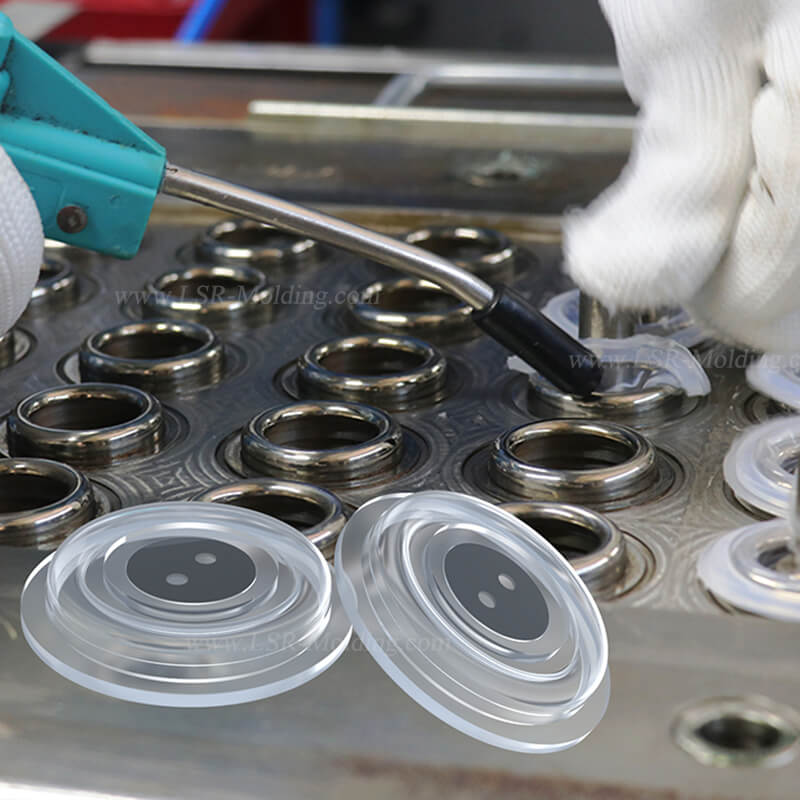Hot Keywords:
- All
- Product Name
- Product Keyword
- Product Model
- Product Summary
- Product Description
- Multi Field Search
Views: 543 Author: Site Editor Publish Time: 2020-10-26 Origin: Site

Rubber To Metal Bonding|Overmolding With Glue
Rubber Metal Bonding & Rubber Metal Overmolding process is to vulcanize elastomer rubber materials in-mold attaching various metal substrates with pre-coated 
1) Some require the strength of steel and the flexibility and elastomer of rubber, such as Silicone Rubber Diaphragm&Membrane, Rubber Vibration Dampers & Bumpers, Rubber Vibration Isolators, Shock Absorbers, Anti-Vibration Mount and Isolation Mounts.
2) Some require fastening application with rubber overmolding encapsulating inserts, such as insert-molded couplings, filters and screw threaded fasteners. Internal or external threads can be molded directly into the part profile, making it easy to attach other components via screw threads.
3) Some require silicone rubber encapsulate electronic components, such as Voltage Dependent Resistor (VDR) and metal Pins, etc. Flame retardant silicone rubber elastomer widely used for encapsulating electronic parts. Besides, Liquid Silicone Rubber for Injection Overmolding is frequently used in electronics, especially high precision LSR Seals &gaskets.
Notes: Another very similar and common bonding structure is Silicone Plastic Overmolding, which is widely used for medical application, such as Membrane and Medical Mask and Baby Products application.
Rubber To Metal Overmolding processes basically includes some main elements: Metal Substrate, Rubber Elastomer and Bonding Agent & Glue.
Common Metal Substrate usually are stainless steel, carbon steel, aluminum, etc, which overmold different Rubber compound on the intended working application, including neoprene, epdm, nitrile, NBR, HNBR, FKM, Viton, Silicone, LSR.
Glue & Bonding Agent is necessity for Rubber-Bond-To-Metal, which can create robust&stronger adhesion on the bond between metal substrate and elastomer. If without applying glue to prepared metal, the rubber elastomer can’t tightly bond the metal substrate, and it is easy to be taken out from rubber compound, leading to bond failures. Therefore, glue adhesive is an important step during rubber-to-metal bonding process that contribute a robust bonding and a reliable finished part.
Notes:
a.)The metal substrate require a thorough cleaning for completely removing traces of oil, solid lubricant, grease and containment from the metal surface. Next, paint brush the glue on surface of metal substrate evently.
b.) Usually, after finishing painting glue, we will dry the metals in at room temperature. For some product with extremely strict requirement , we need to put them into oven for post-drying under specified temperature for accelerating adhesion before rubber metal bonding process.
Rubber To Metal Bonding-Common Problems Analysis:
1) The burrs and flashing at parting line and on the interface between Rubber Base and Metal substrate.
a) Melting Flow Sealing Design Structure on interface between Rubber Base and Metal substrate is the most important for rubber metal overmolding components. If this sealing design is unreasonable, it will cause some burrs & flashing on surface of metal, which affects not only appearance, but also original functions. Therefore, we must to design an available sealing structure during proceeding manufacturability and Moldability analysis.
b) Mold Precision and Molding Ways
If mold fitting precision is not high and tight enough, the flashings & burrs is easily flowing to metal parts. Rubber-to-metal parts are typically manufactured by LSR Injection Molding, Rubber Injection Molding, Transfer Injection Molding, or Compression Molding processes, based on different requirements and budgets on product. LSR Injection Molding is the most precision one but also most expensive. Compression Molding is the most economic and common process. Rubber Injection Molding and Transfer Injection Molding are not precision as LSR Injection Molding, but it’s better than compression molding.
The more precision molding ways, the less burrs and flashing on parts, but more expensive, especially the mold cost
c) Production Process Control
There are various factors affecting product quality, such as the amount of raw material placed in mold cavities, set pressure of compression machine and ways of painting glue on metal. Improper operation will cause bigger parting line and much burrs & flashing.
2) Cracking defects at parting line.
Product design structure (such as too thick wall thickness) and molding parameters for production will also cause cracking issues at parting line.
3) Locating Design Structure for fastening Metal Substrate during molding process.
Locating structure design of metal substrate should be considered for molding production. If the metal can’t be fastened firmly during process, then much burrs & flashing also existing and overmolding parts will be a failure.
Rubber Metal Bonding By Compression Molding Manufacturing Vedio
Rubber Metal Overmolding By Transfer Injection Molding Manufacturing Vedio
Rubber To Metal Bonded Components By Rubber Injection Molding Manufacturing Vedio
Liquid Silicone To Plastic By LSR Injection Molding Manufacturing Vedio
Contact Us / Product Inquire / Liquid Injection Molding / LSR Molding / Article Inquire / FAQ / Download / Sign In / Register / Gallery / China Hot Products / Hot Products / Liquid Silicone Rubber Molding / Customized service / Request Quote / LSR Mold Design Guide / Liquid Silicone Rubber / Liquid Silicone Rubber Molding / Food Grade Liquid Silicone Rubber / Medical Grade Liquid Silicone Rubber / LSR Seal / Expo News / Industry News / Liquid Injection Molding - Better Silicone Project News / Silicone Materail Certifications / Silicone Umbrella Valves Drawing